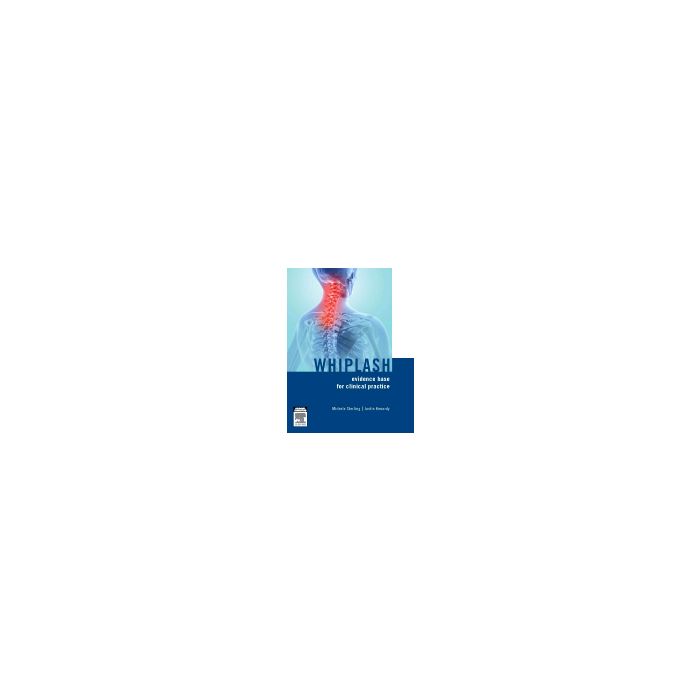Whiplash - Evidence base for clinical practice [Sterling - Elsevier Science]

- ISBN/EAN
- 9780729539463
- Editore
- Elsevier Science
- Formato
- Brossura
- Anno
- 2011
Disponibile
67,00 €
Whiplash injury following a motor vehicle crash is one of the most controversial musculoskeletal pain conditions. In recent years there has been an increased research focus on whiplash associated disorders, particularly in relation to the physical and psychological aspects of the condition.
Whiplash: Evidence base for clinical practice brings together contemporary evidence-base for whiplash including:
a) The epidemiology and magnitude of the problem of whiplash
b) The current understanding of the injury mechanisms and evidence for a pathoanatomical lesion
c) The rapidly expanding areas of the physiological and psychological manifestations of the condition
d) The prediction of outcome in a clinically meaningful way
e) The management of the condition including primary management, secondary and tertiary rehabilitation
f) The controversial roles of compensation and litigation
g) A series of case studies that will aid practitioners in clinical reasoning and decision making for both acute and chronic whiplash
h) Future directions for management of this condition
Key Features
Discreet chapters on litigation, and on the role of compensation.
Case studies on acute and chronic whiplash conditions
Covers the spectrum of the current evidence-base for whiplash - allow all stakeholders involved in the management of patients with whiplash, from clinicians to policy makers, to gain greater understanding of this condition.
Includes perspectives from a wide range of disciplines
Maggiori Informazioni
| Autore | Sterling Michele; Kenardy Justin |
|---|---|
| Editore | Elsevier Science |
| Anno | 2011 |
| Tipologia | Libro |
| Lingua | Inglese |
| Indice | Chapter 1 Epidemiology of whiplash associated disorders Definitions Cumulative incidence of and risk factors for WAD Course and prognosis of WAD after a motor vehicle crash An epidemiological approach to aetiology The economic burden of WAD Summary Chapter 2 Clinical presentation of whiplash associated disorders Patterns of recovery Physical and psychological characteristics Classification systems for WAD Conclusions Chapter 3 Mechanism of injury Head-neck kinematics: global and segmental Injury theories Injury metrics Influencing factors for injury potential Summary Chapter 4 The evidence for pathoanatomical lesions Introduction Pathomechanics of whiplash injury Pathological lesions in whiplash injury Conclusion Chapter 5 Pain-processing mechanisms in whiplash associated disorders Introduction Mechanisms for post-injury central hyperexcitability Evidence for central hyperexcitability in chronic WAD Evidence for central hyperexcitability in acute WAD and in the transition to chronicity Relationships between sensory hypersensitivity and psychological distress Implications for clinical management of whiplash Conclusion Chapter 6 Neuromuscular dysfunction in whiplash associated disorders Changes in the properties of the cervical muscles Altered neuromuscular control in WAD Implications for the management of the patient with whiplash Conclusion Chapter 7 Dizziness, visual and sensorimotor control disturbances following whiplash injury Aetiology of dizziness, visual disturbances and sensorimotor control Disturbances in whiplash associated disorders Signs and symptoms of sensorimotor disturbance following a whiplash injury Implications for assessment Implications for management Conclusion Chapter 8 Psychological aspects of whiplash associated disorders Accident-related psychological factors Coping Catastrophising and kinesiophobia Attributions, beliefs and expectations Conclusion Chapter 9 Potential role of stress systems in the pathogenesis of whiplash associated disorders Sympathetic nervous system Neuropeptide Y Serotonin Clinical implications Current research needs and future research directions Chapter 10 Prognostic indicators of non-recovery following whiplash injury Prognostic factors for non-recovery Prediction of outcomes other than pain and disability Clinical implications Conclusion Chapter 11 Primary care management of acute whiplash injury Current evidence for the management of acute WAD The provision of advice and education Is pain control important? Physical characteristics of acute WAD and implications for management Psychological characteristics of acute WAD and implications for management Early multidisciplinary management Summary Chapter 12 Evidence-based management of chronic whiplash associated disorders Evidence base for management of chronic whiplash Evidence for physical interventions Evidence for psychological interventions Evidence for medical interventions Implementation of evidence in clinical practice Summary Chapter 13 Psychological management of chronic whiplash associated disorders Theory-derived psychological interventions Evidence-based practice Remaining issues and future prospects Conclusion Chapter 14 Compensation and health outcomes Introduction Compensation and related concepts Compensation: empirical considerations Health: the concept and its measurement Conclusions Chapter 15 Whiplash and the law The test for compensability Canadian Transport Accident Compensation Conclusions Chapter 16 Malingering and symptom magnification in whiplash Associated disorders Why study malingering in the area of whiplash? What is meant by ?malingering?? Approaches to detection of malingering Differential diagnosis of psychological disorders where symptom production or magnification is a feature Empirical studies of malingering and symptom magnification in pain A decision-making template for possible and probable malingering Chapter 17 Case descriptions Case description 1: acute whiplash Case description 2: acute whiplash Summary of cases 1 and 2 Case description 3: chronic whiplash Conclusion Chapter 18 Future directions Intervention trials Do some patients have a pre-existing risk of developing chronic pain after whiplash injury? Improving prognostic models Identification of a peripheral lesion Conclusion |
Questo libro è anche in:
